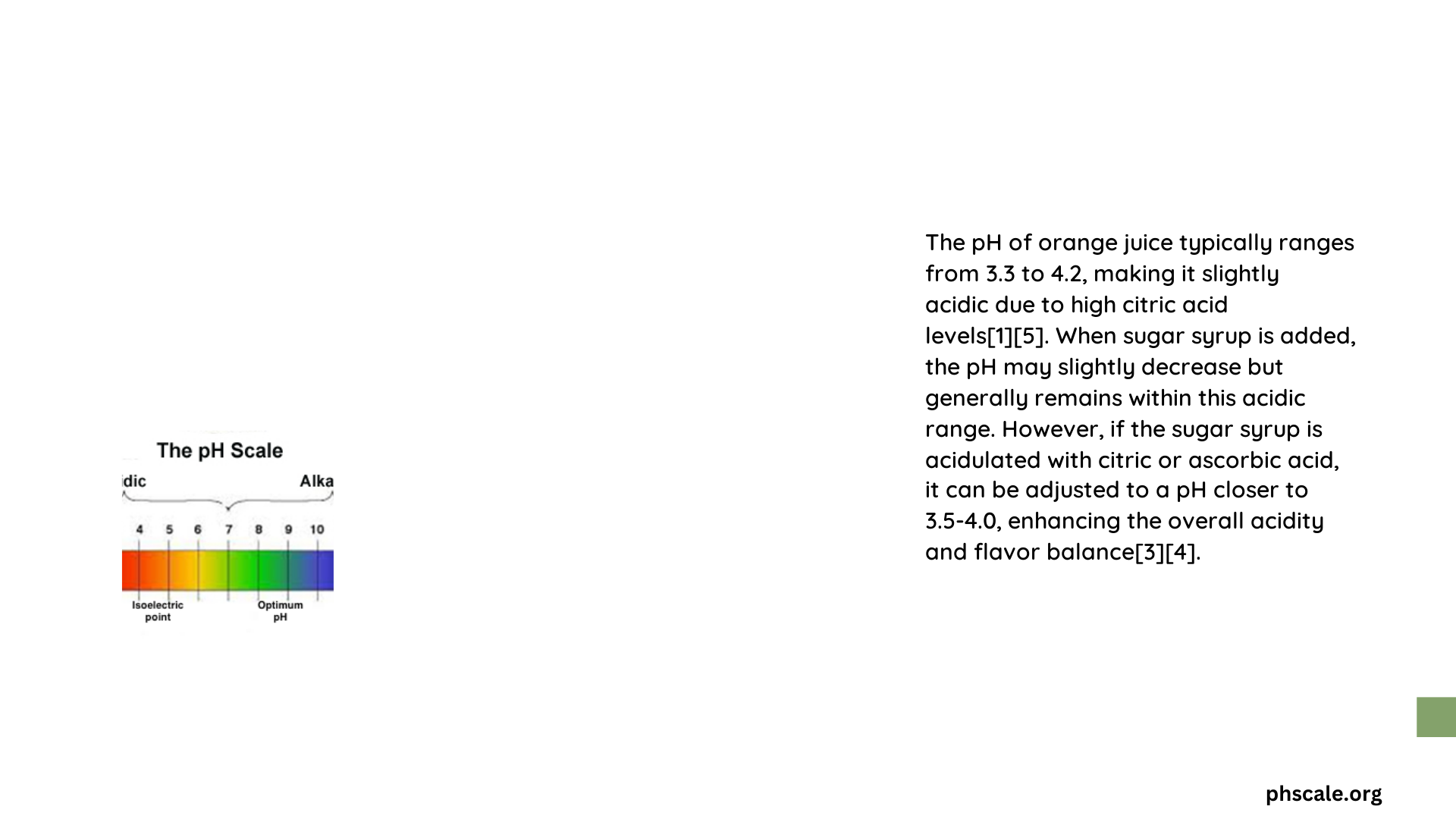The pH of orange juice with sugar syrup typically ranges from 3.2 to 3.8, primarily due to its natural citric acid content. Adding sugar syrup does not significantly alter the pH, as sugar doesn’t release hydrogen ions. The acidity remains stable around 3.5, even with varying sugar concentrations. This stability is crucial for maintaining the juice’s flavor, cloud stability, and overall quality.
What is the Typical pH Range of Orange Juice with Sugar Syrup?
Orange juice, whether with or without added sugar syrup, generally maintains a pH range of 3.2 to 3.8. This acidic nature is primarily due to the presence of citric acid, which is naturally occurring in oranges. The addition of sugar syrup does not significantly impact this pH range for several reasons:
- Sugar (sucrose, glucose, fructose) does not dissociate into ions that would alter the pH.
- The acids present in orange juice (mainly citric and malic acids) are the primary determinants of its pH.
- Sugar dissolves in the juice but does not react chemically with these acids.
Here’s a breakdown of the typical pH ranges:
| Orange Juice Type | pH Range |
|---|---|
| Natural | 3.2 – 3.8 |
| With Sugar Syrup | 3.2 – 3.8 |
How Does Sugar Syrup Affect the Acidity of Orange Juice?

Contrary to what one might expect, the addition of sugar syrup to orange juice does not significantly alter its acidity. This is because:
- Sugar does not release hydrogen ions (H+) when dissolved in water or juice.
- The acidity of orange juice is primarily determined by its citric acid content.
- Sugar molecules do not participate in acid-base reactions.
The chemical reaction for measuring acidity in orange juice involves titrating the juice with a base, typically sodium hydroxide (NaOH), until a neutral pH is reached. The addition of sugar does not affect this titration process because sugar does not participate in the acid-base reaction.
What is the Optimal pH Range for Orange Juice with Sugar Syrup?
The optimal pH range for orange juice, regardless of sugar syrup addition, is generally between 3.2 and 3.8. This range is crucial for several reasons:
- Consumer Preference: This pH range provides a balance between sweetness and acidity that consumers find appealing.
- Juice Stability: The stability of the juice, including its cloud and flavor, is maintained within this pH range.
- Microbial Safety: The acidic nature helps prevent the growth of harmful microorganisms.
It’s important to note that while the pH remains relatively constant, the perceived sweetness and overall flavor profile can be adjusted by changing the Brix/acid ratio. This is often achieved by blending juices with different ratios rather than altering the pH directly.
What Factors Influence the pH of Orange Juice with Sugar Syrup?
Several factors can influence the pH of orange juice, even when sugar syrup is added:
- Orange Variety: Different orange varieties can have slightly different acid contents, affecting the base pH of the juice.
- Ripeness: The ripeness of the oranges at the time of juicing can impact acid levels.
- Processing Methods: Heat treatment and other processing techniques may slightly alter the pH.
- Storage Conditions: Temperature and duration of storage can affect the pH over time.
- Water Quality: If water is added during processing, its pH can influence the final product.
It’s worth noting that while these factors can cause slight variations, the overall pH range typically remains within the 3.2 to 3.8 range.
How is pH Measured in Orange Juice with Sugar Syrup?
Accurate pH measurement is crucial for quality control in orange juice production. Here are the recommended techniques for measuring the pH of orange juice with or without sugar syrup:
- pH Meter Method:
- Use a calibrated pH meter with a glass electrode.
- Calibrate the meter using standard buffer solutions (usually pH 4.0 and 7.0).
- Rinse the electrode with distilled water between measurements.
-
Immerse the electrode in the juice sample and record the stable reading.
-
Titration Method:
- Use a base like sodium hydroxide (NaOH) to titrate the juice.
- Add the base under constant agitation until a specific pH is reached (typically 8.1 to 8.2).
-
Use either a pH electrode or a pH color indicator to determine the endpoint.
-
pH Color Indicator Method:
- Use a sensitive pH color indicator like phenolphthalein.
- Add the indicator to a small sample of juice.
- Observe the color change, which occurs abruptly at a specific pH (e.g., pH 8.2 for phenolphthalein).
Each method has its advantages, but the pH meter is often preferred for its accuracy and ease of use in industrial settings.
Why is pH Control Important in Orange Juice Production?
Maintaining the correct pH in orange juice production, even when adding sugar syrup, is crucial for several reasons:
- Flavor Profile: The pH directly affects the taste and overall sensory experience of the juice.
- Microbial Safety: The acidic pH helps prevent the growth of harmful bacteria and molds.
- Cloud Stability: Proper pH helps maintain the desirable cloudy appearance of orange juice.
- Nutritional Value: Vitamin C stability is pH-dependent, with better retention in acidic conditions.
- Shelf Life: Correct pH contributes to extended shelf life by inhibiting spoilage organisms.
- Quality Consistency: Maintaining a consistent pH ensures product uniformity across batches.
Can Sugar Syrup Addition Mask Changes in Orange Juice pH?
While sugar syrup addition doesn’t significantly alter the pH of orange juice, it can mask perceived changes in acidity. Here’s how:
- Sweetness Perception: Increased sweetness from sugar can balance the perception of acidity, even if the pH remains unchanged.
- Flavor Complexity: Sugar adds complexity to the flavor profile, potentially distracting from subtle pH variations.
- Mouthfeel: Sugar can alter the mouthfeel of the juice, which may influence how acidity is perceived.
It’s important to note that while these sensory changes occur, they do not reflect actual changes in the pH of the juice. Regular pH testing is still necessary to ensure product consistency and safety.
What Are the Implications of pH on Orange Juice Packaging and Storage?
The pH of orange juice, including those with added sugar syrup, has significant implications for packaging and storage:
- Package Material Selection: The acidic nature of orange juice requires packaging materials that can withstand low pH without degradation or leaching.
- Shelf Life Determination: pH is a crucial factor in determining the shelf life of the product.
- Storage Temperature: While pH remains relatively stable, proper storage temperature is essential to maintain overall quality.
- Pasteurization Requirements: The acidic pH allows for less severe heat treatment during pasteurization.
- Label Information: pH levels may influence nutritional labeling and storage instructions.
Understanding these implications helps manufacturers optimize their packaging and storage strategies to maintain product quality and safety.
In conclusion, the pH of orange juice with sugar syrup remains a critical factor in its production, quality, and safety. While sugar syrup addition doesn’t significantly alter the pH, it’s essential to monitor and control this parameter throughout the production process to ensure a consistent, high-quality product that meets consumer expectations and safety standards.
References:
1. Orange juice quality and categories
2. Sugar Composition Analysis of Commercial Citrus Juice Products
3. The Importance of Food pH in Commercial Canning Operations
